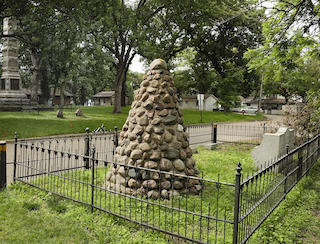
The Abbie Gardner Cabin and Museum in Spirit Lake, with the cabin the background. Photo by Jerry L. Mennenga, www.lostinsiouxland.com.
Jan/Feb 2023 (Volume 15, Issue 1)
By Cheryl Tevis
The Abbie Gardner Cabin and Museum in Spirit Lake form a towering gateway to Iowa’s frontier past. However, preserved within the walls of a small log cabin museum in Woodbury County is a less well-known history of an Iowa town handed down through the generations: the role of Smithland in the events leading up to the 1857 Spirit Lake Massacre.

A portrait of Abbie Gardner.
In 1855, my great-great-grandfather Elijah Adams purchased 320 acres near Smithland for $3.60 an acre. In the spring of 1856, he led a small caravan of settlers there from Rock Island County, Ill., including his wife, Rebecca, and their family of four. His older sons, Wallace and Harry Adams, rode their horses behind the caravan, herding 100 head of cattle and nine yokes of oxen. The wagons crossed the Mississippi River at Davenport on May 12, 1856, on a steamboat ferry. The families arrived in Woodbury County near the banks of the Little Sioux River on June 5.
Wallace Adams, who was 15 years old in 1856, wrote a reminiscence in 1925 about incidents on the western Iowa frontier foreshadowing the final violent clash in March of 1857 between Spirit Lake settlers and American Indians. He also is a named source in yellowed news clippings saved by my grandmother and in State Historical Society of Iowa archived letters, written to historian Frank Herriott.
However, after moving to Boone County in 1984, I read of a pivotal link between the Spirit Lake Massacre and a young boy’s grave marker and historical plaque on the banks of the Des Moines River. It seemed at odds with my relative’s Woodbury County memoir.
The Adams family’s story is set against the backdrop of severe weather as a precipitating factor in the trail leading to Spirit Lake. History books confirm that the winter of 1856-57 was an Iowa winter of epic proportions. Wallace Adams was so concerned about being accused of exaggeration in his reminiscence that he quoted the Rev. Landon Taylor, a presiding elder of the Methodist Church in northwest Iowa.
A three-day blizzard arrived on Dec. 1, 1856. It was followed by weeks of relentless wind and intermittent snow, accumulating to a depth of four feet. Combined with freezing temperatures, it produced a crust “hard enough to bear a man.” No one could leave for supplies. Elijah Adams, his sons, and hired workers had harvested 150 tons of prairie meadow hay to sustain his cattle through winter. However, a rapidly moving fire set by a settler one mile to the south had destroyed two-thirds of the hay. Adams wrote that the heavy snows and frigid weather, combined with lack of forage, caused a loss of 50 head of their cattle by May 1.
In 1918, Thomas Teakle, an historian and educator, and author of the first scholarly book, “The Spirit Lake Massacre,” described the winter in this way: “Although the white settlers suffered considerably from self-imposed denial of food and from unsuitable houses in which to shelter themselves, their privations could not compare with those of the Indians.”
TO READ THE ENTIRE STORY AND OTHER FASCINATING STORIES ABOUT IOWA HISTORY, subscribe to Iowa History Journal.
